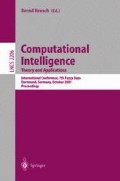Abstract
Near-infrared spectroscopy (NIRS) is a recently developed method, which can investigate the human brain function with noninvasive, high time resolution, and high portability. However, there are few discussions on post-processing of time series data taken by the NIRS because of the difficulty of understanding the obtained data and the complexity of the human higher-order brain function. This paper discusses on an analysis of such a time series. The analysis method is based on fuzzy c-means (FCM) clustering and wavelet transform, and it divides the time series of a measurement point into some clusters with respect to wavelet coefficients. To evaluate the performance of the method, it has been applied to four healthy volunteers, and three brain-dead patients. The results showed that the proposed method could segment the NIRS time series into some clusters that may represent brain states, and could estimate the number of clusters.
Access this chapter
Tax calculation will be finalised at checkout
Purchases are for personal use only
Preview
Unable to display preview. Download preview PDF.
References
F. F. Jobsis, “Noninvasive infrared monitoring of cerebral, and myocardial oxygen sufficiency and circulatory parameters,” Science, no. 198, pp. 1264–1267, 1977.
A. Villinger, J. Planck, C. Hock, L. Schleinkofer, and U. Dirnagl, “Near infrared spectroscopy (NIRS): a new tool to study hemodynamic changes during activation of brain function in human adults,” Neuroscience Letters, vol. 153, pp. 101–104, 1993.
V. Toronov, A. Webb A, J. H. Choi, M. Wolf, A. Michalos, E. Gratton, and D. Hueber, “Investigation of human brain hemodynamics by simultaneous near-infrared spectroscopy and functional magnetic resonance imaging,” Medical Physics, vol. 28, no. 4, pp. 521–527, 2001.
Y. Hoshi, and M. Tamura, “Near-infrared optical detection of sequential brain activation in the prefrontal cortex during mental tasks,” Neuroimage, vol. 5, no. 4, pp. 292–297, 1997.
P. Zaramella, F. Freato, A. Amigoni, S. Salvadori, P. Marangoni, A. Suppjei, B. Schiavo, and L. Chiandetti, “Brain auditory activation measured by near-infrared spectroscopy (NIRS) in neonates,” Pediatric Research, vol. 49, no. 2, pp. 213–219, 2001.
G. Gratton, and P. M. Corballis, “Removing the heart from the brain: Compensation for the pulse artifact in the photon migration signal,” Psychophysiology, vol. 32, pp. 292–299, 1995.
S. Sternberk, “High speed scanning in human memory,” Science, vol. 153, pp. 652–654, 1966.
S. Clare, M. Humberstone, J. Hykin, L. D. Blumhardt, R. Bowtell, and P. Morris, “Detecting activations in event-related fMRI using analysis of variance,” Magnetic Resonance in Medicine, vol. 42, no. 6, pp. 1117–1122, 1999.
J. C. Bezdek, Pattern Recognition with Fuzzy Objective Function Algorithms, Plenum, New York.
M. C. Clark, L. O. Hall, D. B. Goldgof, R. Velthuizen, F. R. Murtagh, and M. S. Silbiger, “Automatic tumor segmentation using knowledge-based techniques,” IEEE Transactions on Medical Imaging, vol. 17, no. 2, pp. 187–201, 1998.
L. M. Fletcher-Heath, L. O. Hall, D. B. Goldgof, and F. R. Murtagh, “Automatic segmentation of non-enhancing brain tumors in magnetic resonance images,” Artificial Intelligence in Medicine, vol. 21, pp. 43–63, 2001.
C. Goutte, P. Toft, E. Rostrup, F. A. Nielse, and L. K. Hansen, “On clustering fMRI time series,” NeuroImage, vol. 9, pp. 297–310, 1999.
G. Gratton, and M. Fabiani, “Dynamic brain imaging: Event-related optical signal (EROS) measures of the time course and localization of cognitive-related activity,” Psychomic Bulletin & Review, vol. 5, no. 4, pp. 535–563, 1998.
S. Wray, M. Cope, D. T. Delpy, J. S. Wyatt, and E. O. R. Reynolds, “Characterization of the near infrared absorption spectra of cytochrome aa3 and hemoglobin for the noninvasive monitoring of cerebral oxygenation,” International Journal of Biochemistry, Biophysics and Molecular Biology, vol. 933, pp. 184–192, 1988.
M. Sun, and R. J. Sclabassi, “Wavelet feature extraction from neurophysioological signals,” in contribution to Time-Frequency and Wavelet Transforms in Biomedicine, M. Akay, Ed. NJ, IEEE Press.
T. Kalayci, and O. Ozdamar, “Wavelet preprocessing for automated neural network detection of EEG spikes,” IEEE Engineering in Medicine and Biology, vol. 14, no. 3, pp. 160–166, 1995.
Author information
Authors and Affiliations
Editor information
Editors and Affiliations
Rights and permissions
Copyright information
© 2001 Springer-Verlag Berlin Heidelberg
About this paper
Cite this paper
Kobashi, S., Hata, Y., Kitamura, Y.T., Hayakata, T., Yanagida, T. (2001). Brain State Recognition Using Fuzzy C-Means (FCM) Clustering with Near Infrared Spectroscopy (NIRS). In: Reusch, B. (eds) Computational Intelligence. Theory and Applications. Fuzzy Days 2001. Lecture Notes in Computer Science, vol 2206. Springer, Berlin, Heidelberg. https://doi.org/10.1007/3-540-45493-4_17
Download citation
DOI: https://doi.org/10.1007/3-540-45493-4_17
Published:
Publisher Name: Springer, Berlin, Heidelberg
Print ISBN: 978-3-540-42732-2
Online ISBN: 978-3-540-45493-9
eBook Packages: Springer Book Archive

